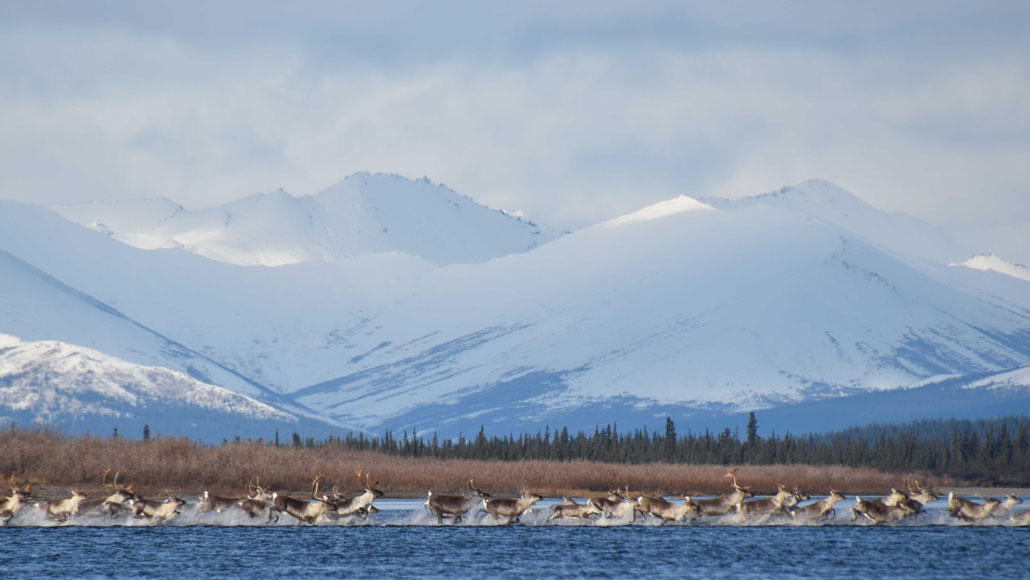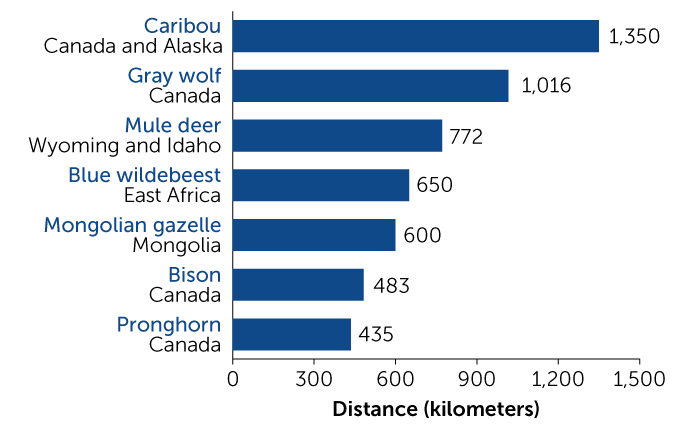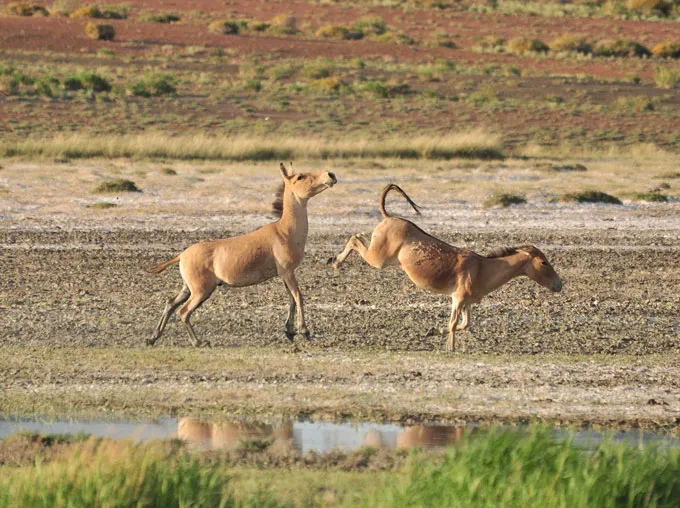
Some herds of caribou migrate between 1,250 and 1,350 kilometers in Canada and Alaska each year to get from their wintering grounds to breeding grounds and back again.
K. Joly/National Park Service
Some animals really go the distance to find food, a mate or a place to raise their young. And now, thanks to scientists’ tracking efforts, we know just how far some land species will travel.
Using decades of scientific observations, researchers determined round-trip migration distances for a number of animals. Caribou have the longest migrations, with two different herds in Alaska and Canada traveling up to 1,350 kilometers per year, the team reports October 25 in Scientific Reports. That’s a little less than the distance from Los Angeles to Portland, Ore.
Gray wolves (Canis lupus) aren’t usually migratory, but a Canadian group thought to follow caribou is the only other tracked species that migrated over 1,000 kilometers in a year, the scientists found.
In the contiguous United States, mule deer (Odocoileus hemionus) have the longest annual land migrations, traveling up to 772 kilometers in Wyoming and Idaho. Other animals performing annual long-haul migrations — each around 600 to 700 kilometers round trip — include the blue wildebeest (Connochaetes taurinus) in the Serengeti of Africa, and the Mongolian gazelle (Procapra gutturosa) and Tibetan antelope (Pantholops hodgsonii) in Asia.
Pronghorn (Antilocapra americana) in Wyoming and Montana migrate about 300 kilometers, while pronghorns in Canada travel some 435 kilometers per year.
The researchers calculated the migration distances by measuring a straight line between the two migratory end points, and then doubling that for a round-trip figure. While the distances are impressive, they are still far short of the thousands of kilometers traveled each year by migrating insects (SN: 4/5/18) or birds (SN: 2/7/17), which can be less encumbered by infrastructure.
“For land animals, something as small as a road could be a barrier,” says Claire Teitelbaum, an ecologist at the University of Georgia in Athens who was not involved in this study. “A fence or wall certainly would be.”
Infrastructure, including roads and cities, already has hampered some animals’ land migrations, scientists say. And climate change could be having an effect by altering environments and the availability of foods, Teitelbaum says. Previous research had found that a herd of caribou (Rangifer tarandus) in Canada, for example, migrated up to 1,500 kilometers annually in the early 2000s when the herd had more members, instead of the current maximum of 1,350 kilometers. But it’s not clear exactly what caused that journey to be shortened.
Going the distance
Some caribou in Alaska and Canada have the longest annual migration route of any land animal, in part because these herds have lots of room to roam, a study finds. Gray wolves aren’t usually migratory, but a Canadian group thought to follow caribou is the only other tracked species that migrated over 1,000 kilometers in a year.
Round-trip animal migrations over land


Source: K. Joly et al/Scientific Reports 2019
Only 7 percent of unbroken land patches worldwide are larger than 100 square kilometers, leading some scientists to predict shorter land migrations to come. “We will see migration distances declining, rather than increasing, into the future,” says Marlee Tucker, an ecologist at Radboud University in Nijmegen, Netherlands, who wasn’t involved with the work. “These [natural] areas are shrinking.”
Understanding where animals roam could help scientists and policy makers prioritize which areas to preserve. That information could also help them decide where to establish wildlife corridors — long strips of natural land or tunnels beneath roads that connect animal habitats.
Most animals with the longest migrations were in Alaska or Canada, where there are large swathes of wild terrain. “The north is much less developed than the lower 48 [states], so there’s much more room for those migrations,” says coauthor Kyle Joly, a National Park Service wildlife biologist based at the Gates of the Arctic National Park and Preserve in northern Alaska. Because temperatures can change drastically in the region, and vegetation in some places is scarce, “these animals need to roam over greater distances,” Joly says.
The researchers also determined the total cumulative distance traveled in a year for the animals in the study using GPS data. While the team expected that the large, hooved animals would cover long distances, the data on cumulative distances revealed a surprising find, Joly says. Predators covered more total ground than their prey.
The most well-traveled animal was a gray wolf in Mongolia that covered 7,247 kilometers in one year while being tracked from 2003 to 2005. Arctic foxes (Vulpes lagopus) and Mongolian wild asses, also called khulans (Equus hemionus hemionus), also surpassed 5,000 kilometers in a year.

In Alaska and Canada, gray wolves racked up more distance than the caribou they hunted. The same held true for gray wolves stalking khulans in Mongolia, as well as brown bears (Ursus arctos) hunting Alaskan moose (Alces alces gigas).
“The total scope of the movements is important to let people know what the scale of the conservation … measures need to be,” Joly says.






